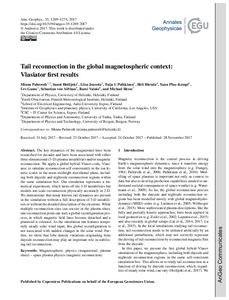Tail reconnection in the global magnetospheric context: Vlasiator first results
Sanni Hoilijoki; Tuija I. Pulkkinen; Sebastian von Alfthan; Liisa Juusola; Heli Hietala; Urs Ganse; Rami Vainio; Minna Palmroth; Michael Hesse; Yann Pfau-Kempf
Tail reconnection in the global magnetospheric context: Vlasiator first results
Sanni Hoilijoki
Tuija I. Pulkkinen
Sebastian von Alfthan
Liisa Juusola
Heli Hietala
Urs Ganse
Rami Vainio
Minna Palmroth
Michael Hesse
Yann Pfau-Kempf
COPERNICUS GESELLSCHAFT MBH
Julkaisun pysyvä osoite on:
https://urn.fi/URN:NBN:fi-fe2021042717748
https://urn.fi/URN:NBN:fi-fe2021042717748
Tiivistelmä
The key dynamics of the magnetotail have been researched for decades and have been associated with either three-dimensional (3-D) plasma instabilities and/or magnetic reconnection. We apply a global hybrid-Vlasov code, Vlasiator, to simulate reconnection self-consistently in the ion kinetic scales in the noon-midnight meridional plane, including both dayside and nightside reconnection regions within the same simulation box. Our simulation represents a numerical experiment, which turns off the 3-D instabilities but models ion-scale reconnection physically accurately in 2-D. We demonstrate that many known tail dynamics are present in the simulation without a full description of 3-D instabilities or without the detailed description of the electrons. While multiple reconnection sites can coexist in the plasma sheet, one reconnection point can start a global reconfiguration process, in which magnetic field lines become detached and a plasmoid is released. As the simulation run features temporally steady solar wind input, this global reconfiguration is not associated with sudden changes in the solar wind. Further, we show that lobe density variations originating from dayside reconnection may play an important role in stabilising tail reconnection.
Kokoelmat
- Rinnakkaistallenteet [19207]
